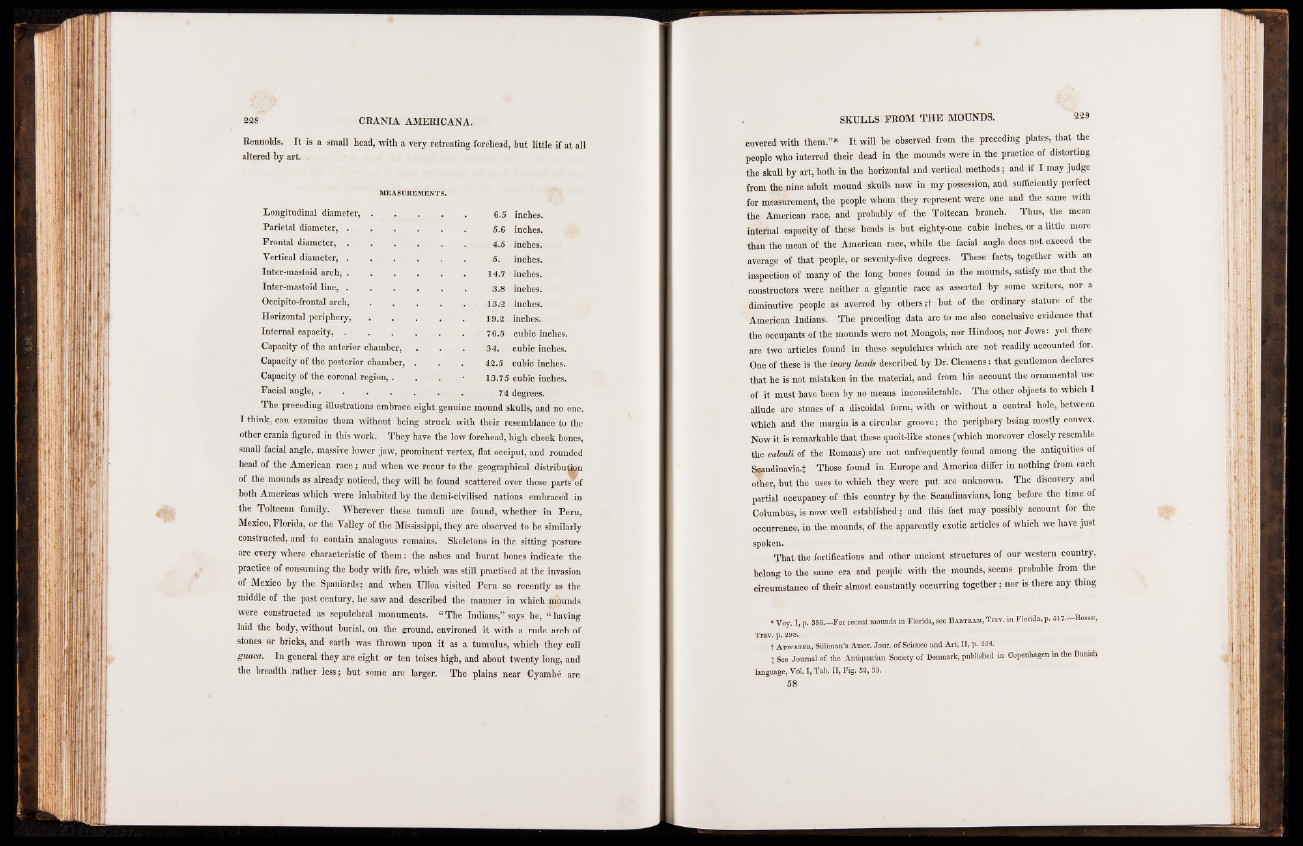
Rennolds. It is a small head, with a very retreating forehead, but little if at all
altered by art. .
MEASUREMENTS.
6.5 inches.
5.6 inches.
4.5 inches.
5. inches.
14.7 inches.
3.8 inches,
13.2
19.2
76.5
34.
42.5
Longitudinal diameter,
Parietal diameter,
Frontal diameter,
Vertical diameter,
Inter-mastoid arch,
Inter-mastoid line,
Occipito-frontal arch,
Horizontal periphery.
Internal capacity, .
Capacity of the anterior chamber,
Capacity of the posterior chamber.
Capacity of the coronal region,.
Facial angle, . . . .
The preceding illustrations embrace eight genuim
inches,
inches,
cubic inches,
cubic inches,
cubic inches.
13.75 cubic inches.
74 degrees,
e mound skulls, and no one,
I think, can examine them without being struck with their resemblance to the
other crania figured in this work. They have the low forehead, high cheek bones,
small facial angle, massive lower jaw, prominent vertex, flat occiput, and rounded
head of the American race ; and when we recur to the geographical distributism
of the mounds as already noticed, they will be found scattered over those p a r t^ f
both Americas which were inhabited by the demi-civilised nations embraced in
the Toltecan family. Wherever these tumuli are found, whether in Peru,
Mexico, Florida, or the Valley of the Mississippi, they are observed to be similarly
constructed, and to contain analogous remains. Skeletons in the sitting posture
are every where characteristic of them : the ashes and burnt bones indicate the
practice of consuming the body with fire, which was still practised at the invasion
of Mexico by the Spaniards ; and when Ulloa visited Peru so recently as the
middle of the past century, he saw and described the manner in which mounds
were constructed as sepulchral monuments. u The Indians,” says he, “ having
laid the body, without burial, on the ground, environed it with a rude arch of
stones or bricks, and earth was thrown upon it as a tumulus, which they call
guaca. In general they are eight or ten toises high, and about twenty long, and
the breadth rather less; but some are larger. The plains near Cyambe are
covered with them.”* It will be observed from the preceding plates, that the
people who interred their dead in the mounds were in the practice of distorting
the skull by art, both in the horizontal and vertical methods; and if I may judge
from the nine adult mound skulls now in my possession, and sufficiently perfect
for measurement, the people whom they represent were one and the same with
the American race, and probably of the Toltecan branch. Thus, the mean
internal capacity of these heads is hut eighty-one cubic inches, or a little more
than the mean of the American race, while the facial angle does not exceed the
average of that people, or seventy-five degrees. These facts, together with an
inspection of many of the long bones found in the mounds, satisfy me that the
constructors were neither a gigantic race as asserted by some writers, nor a
diminutive people as averred by others;! but of the ordinary stature of the
American Indians. The preceding data are to me also conclusive evidence that
the occupants of the mounds were not Mongols, nor Hindoos, nor Jews: yet there
are two articles found in these sepulchres which are not readily accounted for.
One of these is the ivory beads described by Dr. Clemens: that gentleman declares
that he is not mistaken in the material, and from his account the ornamental use
of it must have been by no means inconsiderable. The other objects to which I
allude are stones of a discoidal form, with or without a central hole, between
which and the margin is a circular groove; the periphery being mostly convex.
Now it is remarkable that these quoit-like stones (which moreover closely resemble
the calculi of the Romans) are not unfrequently found among the antiquities of
Scandinavia-! Those found in Europe and America differ in nothing from each
other, but the uses to which they were put are unknown. The discovery and
partial occupancy of this country by the Scandinavians, long before the time of
Columbus, is now well established; and this fact may possibly account for the
occurrence, in the mounds, of the apparently exotic articles of which we have just
spoken.
That the fortifications and other ancient structures of our western country,
belong to the same era and people with the mounds, seems probable from the
circumstance of their almost constantly occurring together; nor is there any thing
* Voy. I, p. 366.—For recent mounds in Florida, see Bartram, Trav. in Florida, p. 517. Bosstj,
Trav. p. 298.
t Atwater, Silliman’s Amer. Jour, of Science and Art, II, p. 224.
X See Journal of the Antiquarian Society of Denmark, published in Copenhagen in the Danish
language, Vol. I, Tab. II, Fig. 52, 53.
58